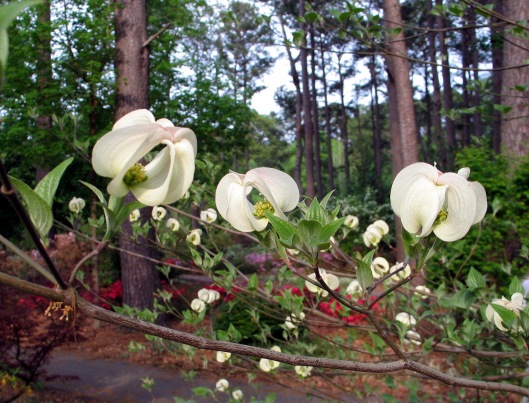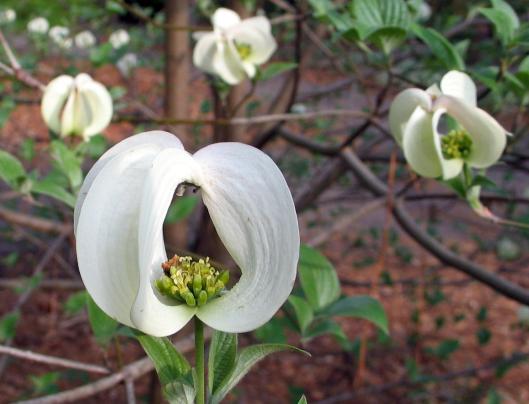Have you ever noticed that some things go full circle? You start somewhere, wander here and there, and then years later you end up back where you started? Well, I can say that about our love affair with fruit research at SFA Gardens.
BLUEBERRIES
At SFA, I began a career working with blueberries way back in 1978. Fresh out of Texas A & M University, a PhD on the wall, I was young, fearless and optimistic. I had studied under Dr. Hollis Bowen and J.B. Storey and I thought I knew a thing or two about fruit. The blueberry arena was wide open and the acid soils and climate of East Texas was perfect. I thought, heck, there’s nothing but blue skies ahead. Like everything in Horticulture, things get complicated. The first blueberry fields came into bearing in the 1980s. A marketing cooperative sprang into action. Realities like freezes, floods, oppressive droughts, heat waves, and other acts of God taught me that nothing is easy in Agriculture. Still, the industry survives to this day. Nacogdoches was named the blueberry capitol of Texas and a festival was born that exists to this day. It wasn’t long before blueberry plants were a nursery item in the mass markets as well as the small retail outlets. Blueberries have become part of the backyard garden world in East Texas. All along the way, collaborations with local producers helped SFA make a mark in variety evaluation, frost protection strategies, soil/plant/water studies, pruning practices, and techniques to improve postharvest performance. With thirty years, we have experience. In 2016, we’ve come full circle – we brought our blueberry work back on campus.  Our blueberry plots are located at the north end of the Pineywoods Native Plant Center, open to the public and every plant is labeled. The collection of 70+ varieties (multiples of each) includes the recommended standards, but also includes exciting advanced selections from Dr. Steven Stringer’s program at the USDA station at Poplarville, Mississippi. The following is our variety and selection list, usually three plants of each.
Our blueberry plots are located at the north end of the Pineywoods Native Plant Center, open to the public and every plant is labeled. The collection of 70+ varieties (multiples of each) includes the recommended standards, but also includes exciting advanced selections from Dr. Steven Stringer’s program at the USDA station at Poplarville, Mississippi. The following is our variety and selection list, usually three plants of each.

MUSCADINE GRAPES
Now if that wasn’t enough, in the last year we have created a small drip irrigated vineyard of muscadine grapes, Vitis rotundifolia. Our goal is to display as wide a collection of the species as possible. This new planting is located at the north end of the Pineywoods Native Plant Center at Jimmy Hinds Park. Jimmy Hinds was the first Agriculture teacher at Stephen F. Austin State University and actually farmed with students where this planting now calls home. Jimmy had a penchant for fruit trees and vines, vegetable gardens and he is considered as the father of modern poultry farming in East Texas. The effort to create the collection led our program to collaborate with Dr. Justin Scheiner, grape viticulturist at TAMU, College Station, Texas – and one of our former students. It’s that full circle again. Working with Justin, other universities and a few specialty nurseries we’ve reached 54 varieties of muscadine grapes in the collection. They are cheerful in the bottomland soils of LaNana creek. Because of space issues, only one plant per variety is planted, and again, every plant is labelled.
 Muscadine Varieties Feb 2020
Muscadine Varieties Feb 2020
FIGS
OK, it’s not over yet. We’re into figs! Working with Dr. Allen Owings, LSU, Hammond, we have planted a fig orchard at SFA. The planting includes over 70 varieties at a standard  commercial spacing on drip irrigation. Because of space issues, we have one plant per variety. The list below is a bit premature. Allen Owings just dropped off another ten varieties we did not have!
commercial spacing on drip irrigation. Because of space issues, we have one plant per variety. The list below is a bit premature. Allen Owings just dropped off another ten varieties we did not have!

Fig varieties at the SFA Gardens, December 2016
KIWIFRUIT
Finally, Kiwifruit came to SFA Gardens in 2011 and good crops of the golden kiwi (Actinidia chinensis) has got everyone excited in our region about the potential. This is not just new to SFA, it’s new to the South. A collaboration with Auburn University allowed us to test ‘Golden Dragon’, ‘Golden Sunshine’, and ‘Au-Fitzgerald’ (a green A. decliciosa variety) – – and a collection of male plants. A good crop in 2014 was followed by a great crop in 2015 which was followed by a modest crop this year in 2016. This has led us to expand the project and we’ve begun a collaboration with my alma mater, TAMU at College Station, Texas. It’s that full circle again. Work with Tim Hartmann at College Station we’re hoping to embark on a long term study to find the best varieties and learn how to grow them in Texas. It’s an exciting time for kiwifruit in Texas.


CONCLUSIONS
In the land grant (Texas A & M University in Texas) or private university system there are few variety evaluation programs for blueberries, muscadines, figs or kiwis in Texas or Louisiana. There is a fig variety plot at LSU Hammond under the direction of Dr. Allen Owings and we work closely with that program, sharing germplasm, ideas and results. Dr. Justin Scheiner, TAMU Viticulture, is building a collection of muscadine grapes and we work closely with him. Mr. Tim Hartmann, TAMU Extension, has planted a first kiwifruit plantation at College Station, Texas in the bottomland of the Brazos river. In spite of the low profile of research in Texas and Louisiana, there’s great interest in the farming and gardening community about the potential of alternative fruits. SFA Gardens is a 128 acre resource that has primarily focused on woody and herbaceous ornamentals. However, with the interest in edible landscapes, small market gardeners, and local grown produce, there’s every reason for SFA Gardens to capitalize on the good soils, full sun and high quality irrigation water to create a foundation for fruit studies. Finding the best varieties and the best strategies to grow them is a noble goal. With blueberries, muscadines, figs, and kiwifruit, our goal is simple. We’re going to develop a platform as a germplasm repository second to none – and working with our colleagues in Texas and Louisiana we’re here to find the best strategies for their production. It’s all about planning and planting for a better Texas.


 Fig collection at the SFA Gardens
Fig collection at the SFA Gardens

























 Witches broom, image by Greg Grant
Witches broom, image by Greg Grant